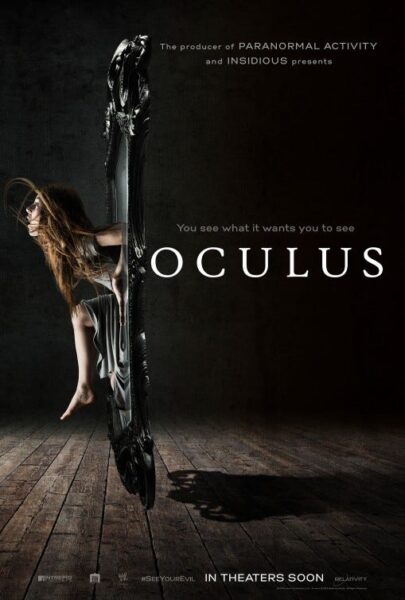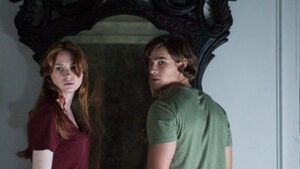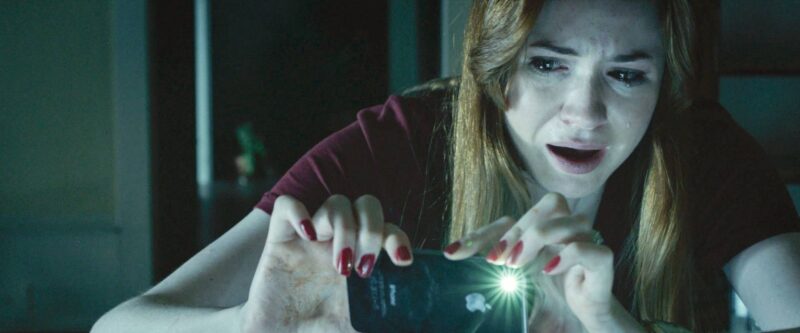Mike Flanagan has written, directed, and adapted some of the most prolific horror films and series to date. Dr. Sleep and The Haunting of Hill House are my more recent favorites. But I also dug some of his earlier works like Hush (2016) and, well, Oculus (2014).
Oculus – Synopsis
Kaylie and Tim survived the brutal deaths of their parents. And now as adults, they are faced with very different recollections of what happened that night putting them at odds with one another. Kaylie believes that their antique mirror is behind the tragedy and that it contains a malevolent, entity that possesses anyone who looks into it. Tim, having spent involuntary time served in a mental health facility, is convinced they misremembered the events of their childhood leading up to the tragedy and insists that Kaylie seeks help.
The pair return to the house with the mirror; Kaylie to get proof and kill the evil once and for all, and Tim, to try and help Kaylie understand that she’s wrong and needs help. The longer they stay in the house, the more timelines begin to blur and confusion sets in on what is and was reality; recalling childhood events, and experiencing strange occurrences in the present. With the whole thing repeating a cycle and ending in tragedy, yet again. But this time, only one sibling survives.
Mike Flanagan directed the film, which he co-wrote with Jeff Howard and Jeff Seidman. It stars Karen Gillan (Guardians of the Galaxy Vol. 3, 2023), Brenton Thwaites (The Giver, 2014), Rory Cochrane (Antlers, 2021), and Katee Sackoff (The Mandalorian, 2023).
Here’s a look at the poster art!

An Ideal Blueprint
Oculus started as a short film (Oculus Chapter 3: The Man with the Plan), which, was also intended to be a series. Lacking the funds to produce them all, Flanagan picked one with enough of the back story to make sense. Oculus Chapter 3 also served as proof of his ability as a director. Which I’d say Mike Flanagan succeeded. Visual storytelling goes beyond the limitation of budget and resource constraints. It’s when you make the most of what you have, and create something cohesive, engaging, and most of all, entertaining, that you create real magic.

Successfully Contained
Set in one location, with essentially one main actor, lots of cuts, and some clever shots to help bring the creepy, Oculus Chapter 3 served as a great blueprint, and proof of concept for what the feature could be with a more expanded storyline and budget. Both short and feature tell the tale of a mysterious mirror that seems to leave a trail of dead bodies in its wake. It’s never revealed why, or what the origin of the mirror’s power is.

Why Oculus Works
With Oculus, you have two perspectives. The mirror has an evil entity that plays tricks on people and makes them do awful things… Or you have people who are in fragile mental or emotional states, and end up cracking as the stress (imagined or not) continues to build until they unwittingly commit a heinous act. Either way, regardless of your beliefs, you may find yourself at the very least, disturbed by Oculus.

What is Reality Even?
When you start questioning reality, when you lose sense of time, or even believe you’ve lost control of yourself. That’s what’s scariest to me. Imagine, believing something to be true, only to discover you were wrong. And your actions as a result of that belief, caused damage, or harm? And even deeper still… not knowing if you were ever really wrong or not? Because what is reality? What really happened? That’s the entirety of Oculus, at least from my perspective.
I love that about playing in the realm of the supernatural. When a story is told in such a way, you have no choice but to be drawn in and get lost in the events that unfold, anything can happen.
Oculus is streaming on PlutoTV, and the short that started it all, Oculus Chapter 3: The Man with the Plan can be found on YouTube.
 PopHorror Let's Get Scared
PopHorror Let's Get Scared




